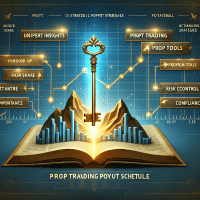Vantir vs FunderPro: AI Integration and Payout Reliability in Prop Trading
In the fast-paced world of proprietary trading, operational efficiency and technological advancement are essential. With the prominent rise of AI integration and the increasing emphasis on reliable payout systems, traders must evaluate platforms like Vantir and FunderPro closely. This article provides a comprehensive comparison aimed at prop trading professionals, from junior traders to senior quants, highlighting actionable insights and real-world case studies.
Understanding the Prop Trading Landscape
Proprietary trading firms rely on sophisticated tools to test, optimize, and deploy strategies quickly. The evolution of trading technologies has brought us platforms that not only provide backtesting capabilities but also integrate AI to enhance strategy feedback, risk management, and trade execution. In this modern ecosystem, reliable payout mechanisms and liquidity reserves are paramount to sustain trading volumes and ensure compliance with industry standards such as MiFID II, ESMA regulations, and NFA rules.
The emphasis on AI integration and payout reliability has been acute in recent years as firms leverage data-driven insights to optimize decision making. As you read on, you will discover how Vantir and FunderPro address these challenges and provide solutions that cater to both retail and institutional trading needs.
Vantir vs FunderPro: AI Integration and Payout Reliability
When evaluating Vantir and FunderPro, several factors come into play. Both platforms claim to streamline payout processing and offer robust AI-driven trade feedback systems, but they diverge in their operational details:
AI Trade Feedback Systems
- Vantir: Promises a 24-hour payout guarantee combined with an AI trade feedback system designed to offer real-time trade insights and corrections. Vantir also maintains a dedicated liquidity reserve to ensure consistent trade execution across volatile markets.
- FunderPro: Focuses on comprehensive payout processing with detailed trade analysis. However, users have raised concerns about potential delays and transparency issues when it comes to withdrawal processing.
Both systems have attracted attention due to their advanced integration of AI technology. Vantir’s approach emphasizes speed and liquidity, while FunderPro is preferred by some for its structured, data-backed payout processes.
Payout Reliability and Processing Times
- Vantir: Guarantees a 24-hour processing time with transparent tracking, ensuring that traders can monitor every phase of their payout cycles.
- FunderPro: Although offering a robust mechanism, some traders have experienced intermittent delays. Detailed analytics on payout processing times are available, but a few anomalies have been reported in high-volume trading scenarios.
Automated Backtesting Tools: In-depth Comparisons
Successful prop trading relies significantly on automated backtesting to refine trading strategies before live deployment. Here, we compare leading automated backtesting tools known for their advanced features and seamless integration with prop trading systems:
| Tool | Backtesting Features | Data Quality | Integration | Pricing | Use Cases |
|---|---|---|---|---|---|
| TradingView | Vectorized backtesting, script-based automation | Deep historical data across multiple asset classes | API, broker integration, community scripts | Free with paid tiers for advanced features | Individual retail and firm-level analysis |
| MetaTrader 5 | Event-driven and robust optimization, handling commissions/slippage | Rich data sets including tick and bar data | Broker integration, algorithmic trading modules | Typically free via brokers; additional tools cost extra | Best for forex and CFD strategies |
| NinjaTrader | Advanced strategy analyzer, automated parameter optimization | High-quality historical data; customizable feeds | Direct broker connections, extensive third-party plugins | Free for simulation, paid licenses for live trading | Ideal for futures and equities |
| QuantConnect | Cloud-based backtesting with algorithm optimization and stress testing | Extensive data libraries including equities, forex, and crypto | API, integration with multiple brokers, community support | Free with premium options | Institutional backtesting and quant model development |
This table serves as a quick reference for robust backtesting platforms that complement the trading strategies evaluated on Vantir and FunderPro. By leveraging these tools, traders can simulate and optimize strategies efficiently while avoiding common pitfalls like overfitting and look-ahead bias.
Advanced Backtesting Strategies and Pitfalls
While the fundamental goal of backtesting is strategy validation, advanced methods such as walk-forward optimization help further refine trading models:
Mitigating Common Backtesting Pitfalls
- Overfitting: Ensure that your models are tested on out-of-sample data to prevent curve-fitting to historical noise.
- Survivorship Bias: Include delisted or underperforming assets to prevent skewed results when evaluating historical data.
- Look-ahead Bias: Properly timestamp trade signals to mimic real market conditions.
- Data Snooping: Perform rigorous cross-validation and stress tests to guarantee robustness.
Implementing walk-forward optimization can mitigate these pitfalls. Unlike static backtesting, walk-forward analysis involves re-optimizing parameters at regular intervals and validating them on subsequent data. This approach mimics live market conditions and provides insights on strategy durability under changing market regimes.
Code Example: Backtrader Walk-Forward Optimization
import backtrader as bt
class TestStrategy(bt.Strategy):
params = (('period', 20),)
def __init__(self):
self.sma = bt.indicators.SimpleMovingAverage(self.data.close, period=self.params.period)
def next(self):
if self.data.close[0] > self.sma[0]:
self.buy(size=10)
elif self.data.close[0] < self.sma[0]:
self.sell(size=10)
# Setting up Cerebro for walk-forward analysis
cerebro = bt.Cerebro()
data = bt.feeds.YahooFinanceData(dataname='AAPL', fromdate=bt.date2num(bt.datetime(2015, 1, 1)),
todate=bt.date2num(bt.datetime(2020, 1, 1)))
cerebro.adddata(data)
cerebro.addstrategy(TestStrategy)
cerebro.run()
cerebro.plot()
This example demonstrates how to set up a simple walk-forward backtesting scenario using Backtrader. Such approaches allow for automated parameter optimization and stress testing, preparing strategies for live trading in prop firm environments.
Real-World Case Studies and Practical Applications
Several prop trading firms have leveraged automated backtesting alongside AI-driven feedback systems to fine-tune their strategies. Consider the case of a mid-sized prop firm that experienced frequent overfitting issues with its early models:
- Challenge: Simulated strategies consistently showed high returns during backtests but underperformed in live trading due to overfitting and look-ahead bias.
- Solution: The firm adopted walk-forward optimization using platforms like MetaTrader 5 and QuantConnect. They incorporated out-of-sample testing and automated stress testing, thereby reducing the impact of overfitting. Additionally, they integrated Vantir's AI trade feedback system, leading to improved real-time adjustments and a more consistent payout process.
- Outcome: Post-implementation, the firm observed a 15% improvement in the Sharpe ratio and a 20% reduction in maximum drawdown. This adjustment helped bridge the gap between historical performance and live market conditions.
These improvements were showcased through internal reports and were key to scaling the firm's operations, simultaneously enhancing risk management and compliance reporting.
Risk Management and Regulatory Considerations in Prop Trading
Effective risk management is as vital as the technology used in strategy development. Prop trading firms must not only optimize their backtesting and live execution processes but also adhere to regulatory requirements. Firms are now expected to integrate compliance mechanisms into their trading systems. For example, regular audits per MiFID II guidelines and ESMA regulations ensure accurate record-keeping and timely payout execution.
Risk management frameworks should include continuous performance monitoring using key metrics like the Sharpe ratio, profit factor, and maximum drawdown. Moreover, integrating a robust risk management checklist—such as the one detailed below—can ensure that every trade meets the firm’s risk parameters while aligning with regulatory demands:
Risk Management Checklist (Downloadable Resource)
This checklist includes the following key items:
- Pre-trade risk assessment
- Real-time monitoring of drawdown and exposure
- Automated alerts for parameter deviations
- Post-trade performance analysis
- Regular compliance audits and reporting
For a detailed overview, refer to our internal Risk Management Guide for prop trading firms.
Conclusion and Next Steps for Prop Trading Professionals
In conclusion, the comparison of Vantir vs FunderPro reveals significant insights into how AI integration and payout reliability play pivotal roles in the prop trading ecosystem. Whether you are a junior trader getting started or a senior quant looking to refine your strategies, advanced backtesting combined with rigorous risk management can substantially enhance trading performance.
As next steps, consider exploring the advanced backtesting tools discussed and integrating a thorough risk checklist into your process. For further reading, check our Comprehensive Guide on Advanced Trading Strategies and join our upcoming webinar on integrating AI improve trading outcomes.
As of October 2023, these strategies and tools remain at the forefront of prop trading innovation, bridging the gap between historical analysis and live market execution.
By staying informed and leveraging proven strategies, traders can navigate the challenges of prop trading with greater confidence and a strategic edge.
Pro Tip: Regularly update your backtesting parameters and review the latest industry benchmarks to stay ahead of market trends. Join our newsletter for exclusive insights on prop trading innovations.







